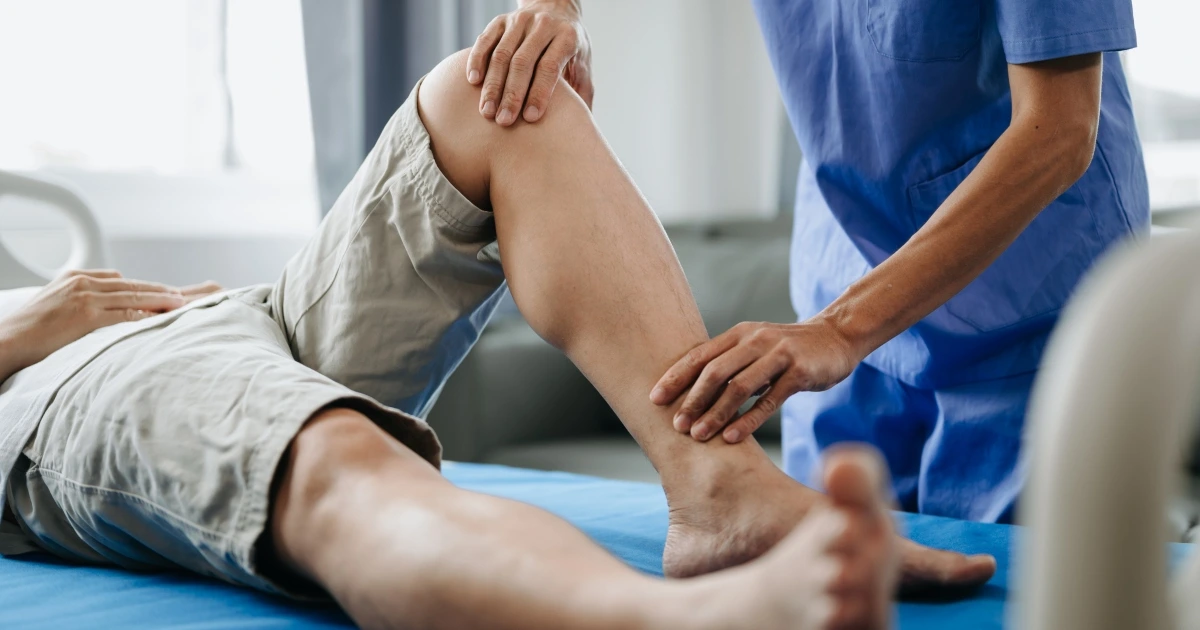Filing a Claim for a Knee Injury From an Ohio Car Crash

Knee injuries can be devastating to your mobility, impacting many aspects of your life. While these injuries have various causes, the trauma of a car accident often causes these debilitating injuries.
Table of Contents
- What To Do After a Car Crash Knee Injury
- How Long Does Knee Pain Last After a Crash?
- Why Am I Experiencing Knee Pain After an Ohio Crash?
- What Symptoms May Indicate a Knee Injury?
- What Are the Main Types of Knee Injuries From Auto Accidents?
- Treatment for a Car Crash Knee Injury
- Call Friedman, Domiano and Smith Today If You Were Injured
If you were diagnosed with a serious knee injury in an Ohio car accident caused by another driver, you might be eligible for compensation to cover medical expenses, lost wages and more. Friedman, Domiano and Smith has been fighting for the injured for over 40 years, obtaining millions in compensation.
We do not charge any upfront fees for our services, and your initial consultation is free.
Discuss your options with our lawyers today: 216-621-0070.
What To Do After a Car Crash Knee Injury
Your top priority is to seek medical care. Doctors can conduct a thorough physical evaluation and run tests to diagnose your specific injury and stabilize it. This can help to prevent the injury from getting worse.
Make sure to keep detailed records of your medical visits, treatments and any expenses incurred. Doing so can help establish how much compensation you may be eligible to claim if you take legal action.
As these injuries can be quite serious, causing physical symptoms, significant pain and keeping you from working, you should strongly consider consulting a lawyer. A lawyer can explain your legal options and manage the legal process on your behalf. This means:
- Dealing with the insurance company
- Gathering medical records and evidence of the crash
- Negotiating for compensation
- Filing a lawsuit if necessary
How Long Does Knee Pain Last After a Crash?
It depends on the injury you suffered. Some of these injuries heal within a couple months. However, more serious knee injuries could cause pain and other symptoms for several months. This is especially true if you need to immobilize the knee for a long period.
Following the doctor’s treatment plan could help speed up your recovery and mitigate pain and other symptoms.
Why Am I Experiencing Knee Pain After an Ohio Crash?
The impact of a collision often forces your body into unnatural positions, which can cause many serious injuries. Your knee, which is composed of bones, cartilage, ligaments and tendons, is particularly vulnerable.
If you are experiencing knee pain after a car crash, it is a sign that your knee has suffered some form of trauma. This is not a symptom you should ignore.
Common reasons for knee pain after a car crash include:
Direct Impact
If your knee is forced or jammed into the dashboard, door or other hard surfaces during the collision, it can cause significant trauma. This direct impact can result in bruising, fractures, or even dislocation of the knee joint. The severity of the injury depends on the force of the impact and the angle at which the knee strikes the surface.
Bruising may be the least severe outcome, causing pain and swelling but typically healing on its own. Fractures, however, can range from hairline cracks to complete breaks in the bones that make up the knee joint (patella, femur, or tibia).
Twisting Motions
Sudden, unnatural twisting movements of your knee can lead to ligament strains or tears. The anterior cruciate ligament (ACL) and medial collateral ligament (MCL) are particularly susceptible to such injuries. The ACL, which runs diagonally in the middle of the knee, helps stabilize the joint during rotational movements. When the body twists while the foot is planted, it can cause the ACL to stretch or tear.
MCL injuries often occur when the outer part of the knee is hit, causing the inner part to stretch.
Hyperextension
During the accident, your knee may be forced to extend beyond its normal range of motion, damaging ligaments and tendons. This can lead to sprains or tears in the posterior cruciate ligament (PCL) or hamstring muscles, resulting in pain and reduced mobility.
Hyperextension occurs when the knee is bent backwards, stretching or tearing the structures at the back of the knee.
The PCL, which prevents the tibia from moving too far backward relative to the femur, is particularly vulnerable to this type of injury.
Hamstring injuries can also occur as these muscles attach behind the knee and can be overstretched during hyperextension.
Compression Forces
The crash’s impact can compress your knee joint, leading to injuries such as fractures or cartilage damage. This compression can cause meniscus tears or damage to the articular cartilage, potentially leading to long-term issues like osteoarthritis.
Compression forces occur when the femur (thighbone) is driven down into the tibia (shinbone), putting extreme pressure on the structures within the knee joint. The meniscus, a C-shaped piece of cartilage that acts as a shock absorber between the femur and tibia, can be torn or crushed under this pressure.
Articular cartilage, which covers the ends of the bones in the joint, can also be damaged, leading to pain, swelling, and potentially accelerated wear and tear of the joint.
Airbag Deployment
This safety device is designed to protect drivers and passengers during an accident, but its forceful deployment could cause serious knee injuries.
Airbags deploy at high speed, and while they are crucial for preventing more severe injuries, they can cause harm if the occupant is too close to the deployment zone. In addition to hyperextension, airbags can cause abrasions or burns to the knee area due to the high-speed deployment and the heat generated by the chemical reaction that inflates the bag.
Seatbelt
During a car crash, a seat belt could rotate or twist your body, causing your knees to strike the interior of the vehicle at an awkward angle. The lap portion of the seatbelt is designed to sit across the pelvis, but in a crash, it can ride up onto the abdomen, allowing the lower body to slide forward.
What Symptoms May Indicate a Knee Injury?
Knee injuries can become apparent in several ways, depending on the type and severity of the injury. Common symptoms that may indicate a knee injury include:
- Swelling and stiffness are often signs of internal bleeding or fluid buildup within the joint.
- Pain when bending or straightening your knee could signify ligament or tendon damage.
- Bruising and redness are common visual signs of trauma around the knee.
- Feeling like your knee might give out when putting weight on it
- Limited range of motion/inability to fully extend or bend your knee
- Popping or clicking sounds when moving the knee, which may indicate cartilage damage or loose fragments in the joint
- Warmth around the knee area, which can be a sign of inflammation or infection.
- Numbness or tingling in the knee or below it, potentially indicating nerve damage or compression
- Visible deformity of the knee, which could suggest a dislocation or severe fracture
- Locking of the knee, where it gets stuck in one position and is difficult to move, often due to a torn meniscus
- Feeling of instability or “looseness” in the knee joint, which could indicate torn ligaments
- Persistent aching or throbbing pain, even when not moving the knee.
- Visible gap or indentation in the kneecap area, which could indicate a patellar tendon rupture.
- Changes in the appearance of the kneecap, such as appearing higher or lower than normal, potentially signifying a patellar dislocation.
- Fluid-filled swelling (effusion) that feels like your knee has a water balloon around it.
If you experience any of these symptoms following a car accident, you need to seek medical attention immediately. Early diagnosis and treatment can prevent your injuries from getting worse and may reduce the risk of long-term complications.
What Are the Main Types of Knee Injuries From Auto Accidents?
There are several types of knee injuries car crash victims might suffer. The most common knee injuries include:
- Sprains and Strains: These occur when ligaments and tendons are overstretched or torn. Sprains affect ligaments, while strains impact muscles or tendons. They can range from mild (Grade I) to severe (Grade III). Symptoms include pain, swelling, and limited mobility.
- Meniscus Tears: This refers to damage to the cartilage that cushions your knee joint. Serious tears often require surgical intervention, such as arthroscopic surgery to repair or remove the damaged tissue. They can be classified as radial, horizontal, or complex tears, each requiring different treatment approaches. Long-term complications may include an increased risk of osteoarthritis.
- Fractures: These are breaks in the bones that make up the knee, such as the kneecap (patella), lower end of the thighbone (femur), or upper part of the shinbone (tibia). Fractures can be simple or comminuted (multiple fragments). They often result from direct impact and may require surgical intervention with pins, plates or screws.
- Dislocations: This type of injury could be severely painful. Victims may feel numbness and tingling. Knee dislocations occur when the bones of the knee are forced out of alignment. They often involve multiple ligament tears and can damage blood vessels and nerves. Immediate medical attention is crucial to prevent complications like compartment syndrome.
- ACL Injuries: For instance, you could tear your anterior cruciate ligament, which often requires surgical intervention. The ACL is crucial for knee stability, especially during pivoting movements.
- MCL Injuries: For instance, victims could tear the medial collateral ligament, which does not require surgery as often as ACL tears but is still a possibility in more severe cases. MCL injuries are graded from I to III based on severity. They often result from a blow to the outer knee. Treatment usually involves bracing and physical therapy, but Grade III tears may require surgical repair.
Treatment for a Car Crash Knee Injury
The treatment for a knee injury depends on the severity and type of injury sustained in the accident. Common options include:
- Rest and Immobilization: Giving your knee time to heal by minimizing movement
- Physical Therapy: Performing exercises to strengthen the muscles around the knee and restore mobility
- Medication: Using pain relief and anti-inflammatory drugs to manage symptoms
- Surgery: In severe cases, surgery may be necessary to repair damaged ligaments, tendons, or bones.
- Assistive Devices: Using crutches, a knee brace, or a wheelchair to reduce weight on the knee during healing
Your doctor will tailor a treatment plan to your specific needs. Adhering to this plan is crucial for an effective recovery. If you push it, you could reinjure the knee and prolong your recovery.
Call Friedman, Domiano and Smith Today If You Were Injured
If you have injured your knee in a car crash that was caused by another driver, dealing with the aftermath can be challenging. It is easy to feel overwhelmed if you are managing your physical recovery and navigating the legal process on your own. However, you do not have to face this journey alone.
We have four decades of advocating for our clients’ rights, securing millions in compensation on their behalf.
Let our experienced lawyers offer legal support during this difficult time. We do not charge any upfront fees.
Schedule your free, no-obligation consultation today: 216-621-0070.
Comments are now closed




Comments